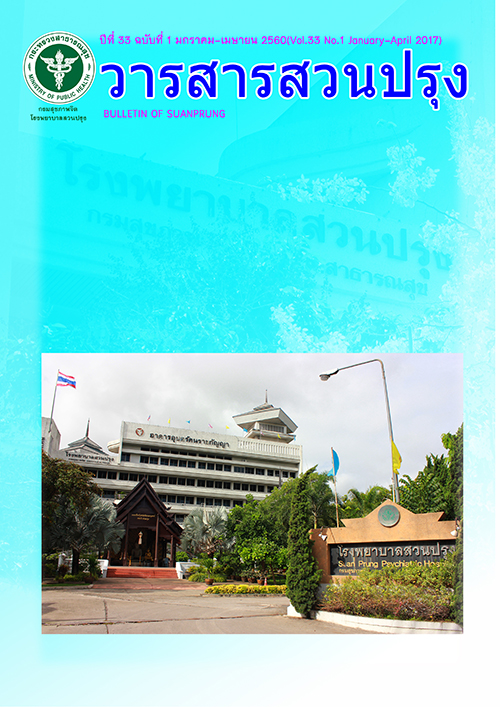ภาวะซึมเศร้า คุณภาพชีวิต และปัจจัยที่มีผลต่อภาวะซึมเศร้าในประชาชน;Depression, Quality of Life and Factors Affecting the Risk of Depression in People Aged more than 50 years, Banmakok Community, Maha Sarakham
Main Article Content
Abstract
บทคัดย่อ
วัตถุประสงค์:การศึกษาภาคตัดขวางเพื่อคัดกรองผู้เสี่ยงต่อภาวะซึมเศร้าในประชาชนอายุ≥50 ปี บ้านมะกอก จังหวัดมหาสารคาม ค้นหาปัจจัยที่มีผลต่อภาวะซึมเศร้าและประเมินคุณภาพชีวิต
วัสดุและวิธีการ:กลุ่มตัวอย่าง 200 คน ได้จากวิธีสุ่มอย่างง่าย เครื่องมือเก็บข้อมูลคือแบบคัดกรองภาวะซึมเศร้า 2 คำถาม (2Q) แบบประเมินภาวะซึมเศร้า 9 คำถาม (9Q) และแบบประเมินคุณภาพชีวิตองค์การอนามัยโลกชุดย่อฉบับภาษาไทย (WHOQOL-BREF-THAI) สัมภาษณ์เก็บข้อมูล ตุลาคม 2556 -มกราคม 2557
ผล:ประชาชนอายุ≥50 ปีส่วนใหญ่เป็นเพศหญิง (ร้อยละ 63.0) อายุเฉลี่ย 65.27±9.51 ปี โรคประจำตัวคือความดันโลหิตสูง และเบาหวาน ผลการคัดกรองด้วย2Q พบผู้เสี่ยง79 คน (ร้อยละ 39.5) ผลประเมินภาวะซึมเศร้า 9Q พบผู้เสี่ยง 64 คน (ร้อยละ 32) ปัจจัยที่มีผลต่อภาวะซึมเศร้าอย่างมีนัยสำคัญมี 7 ปัจจัย ได้แก่ สถานภาพหม้าย ไม่มีงานทำ เป็นผู้สูงอายุตอนปลาย (≥75 ปี) มีรายได้น้อย ใช้ยา> 3 รายการ ดื่มสุรามาก และความสามารถจัดการความเครียดต่ำ สำหรับคุณภาพชีวิตของกลุ่มตัวอย่างภาพรวม สุขภาพกาย จิตใจ และสิ่งแวดล้อมอยู่ในระดับดี ยกเว้นด้านสัมพันธภาพทางสังคมอยู่ในระดับกลางประชาชนก่อนวัยสูงอายุ (50-59 ปี) มีผู้ที่มีคุณภาพชีวิตระดับดีมากกว่าผู้สูงอายุตอนต้น (60-74 ปี) และผู้สูงอายุตอนปลาย (≥75 ปี) อย่างมีนัยสำคัญทางสถิติ (p=0.002) ร้อยละ 89.8, 77.1 และ 58.3 ตามลำดับ
สรุป: ผู้สูงอายุประมาณ 1 ใน 3 มีความเสี่ยงที่จะเกิดภาวะซึมเศร้า ในคนที่อายุมากขึ้นจะมีความเสี่ยงมากขึ้น ส่วนใหญ่มีคุณภาพชีวิตอยู่ในระดับที่ดี
คำ
Abstract
Objectives: to screen depression in people ≥50 years at Banmakok, Maha Sarakham and to investigate the factors affecting on the depression risk, as well as evaluate their quality of life.
Method: 200 participants were selected by the simple random sampling. The study instruments were 2Q depression screening questionnaire, 9Q depression evaluation questionnaire, and 26-item WHOQOL-BREF-THAI. Participants were interviewed from October 2013-January 2014.
Results: Most of the people ≥50 years in Banmakok were female (63.0%). The average age was 65.27±9.51 years. Their personal diseases were hypertension and diabetes mellitus. 10 persons were people with disabilities. Form screening with 2Q, we found 79 persons (39.5%) with depression risk. From 9Q, 64 (32.0%) people at risk of depression were found. Seven significant factors affecting the depression risk were the widow marital status, no occupation, the late age group (>75 years), low monthly income, drug use ≥3 items, severe alcohol drinking, and people unable to manage their stress. For quality of life, most of the participants had the overall of quality of life, the physical, the mental, and the environmental aspect at good levels whereas the social relationship aspect was at the medium level. People in pre-aging group (50-59 years) had a better quality of life than the other 2 elderly groups, the early age group (60-74 years) and the late age group (≥75 years), with a statistical significance (p=0.002) of 89.8%, 77.1% and 58.3%, respectively.
Conclusion: This study showed the number of screened people with depression risk and their quality of life in both pre-aging and aging groups. The results show that the factors affecting the depression risk can be used by the district’s health promoting hospitals or the health volunteers in Banmakok to initiate the surveillance system of depression and quality of life monitoring the people at high risk.
Keywords: Depression, Quality of Life, Risk factors, Screening, Evaluation
สำคัญ: ภาวะซึมเศร้า คุณภาพชีวิต ปัจจัยเสี่ยง คัดกรอง ประเมิน
Article Details
บทความหลังผ่านการปรับแก้จากกองบรรณาธิการแล้ว เป็นลิขสิทธ์ของวารสารจิตเวชวิทยาสาร โรงพยาบาลสวนปรุง กรมสุขภาพจิต กระทรวงสาธารณสุข ห้ามเผยแพร่เพื่อประโยชน์ทางการค้าโดยไม่ได้รับอนุญาต แต่อนุญาตให้เผยแพร่บทความดังกล่าวเพื่อประโยชน์ทางการศึกษาแก่ประชาชนทั่วไป ทั้งนี้กองบรรณาธิการไม่จำเป็นต้องเห็นด้วยกับบทความหรือข้อคิดเห็นใดๆ ที่ปรากฏในวารสารสวนปรุง
References
World Health Organization. Conquering depression: You can get out of the blues. Coodinating Authoe: Sudhir Khandelwal. New Delhi WHO Regional office for South-East Asia 2001: 18-37.
Health Information System Development Office [Internet]. The 4th Report of Health Survey in Thai population by the physical examination 2002-2. [Cited 2015 Aug 1]. Available from: http://www.hiso.or.th/hiso5/report/report1.php.
Apichart Jumraslitthirong, Pramote Prasartkul, Punya Choulerd. Situation of Mental Health in Thai population. Institute for Population and Social Research. Mahidol University. 2010. [Cited 2015 Aug 1]. Available from: http://www.ipsr.mahidol.ac.th/ipsrbeta/FileUpload/PDF/Report-File-368.pdf.
Toranin Kongsook, Suwanna Aroonpaisarn, Wachira Pengjan, Ketsaraporn Kenbuppa, Pannapa kittiratanapaiboon, Roogmanee Yingyeun, et al. The Prevalence of Major Depressive Disorders in Thailand: Results from the Epidemiology of Mental Disorders National Survey. 2008. [Cited 2015 Aug 1]. Available from: http://www.dmh.go.th/downloadportal/Morbidity/Depress2551.pdf.
Suwimon Tirakanant. MER 2003 (MR 203). Principle of Statistics and Educational research. 2013. Bangkok: Ramkhamhaeng University Printing.
Suwanna Aroonpaisarn, Toranin Kongsook, Narong Maneetorn, Benjaluk Maneetorn, Kamonnet Wansawek, et al. Development and Reliability of 2Q Depression screening tool in Isan Thai community. 2007. [Cited 2015 Aug 1]. Available from: http://www.dmh.go.th/abstract/details.asp?id=3532
Toranin Kongsook, Suwanna Aroonpaisarn, Narong Maneetorn, Benjaluk Maneetorn, Kamonnet Wansawek, Ketsaraporn Kenbuppa. Development and Reliability of 9Q Depression Evaluation tool in Isan Thai community. 2007 [Cited 2015 Aug 1]. Available from: http:// www.prasri.go.th/upic/ie.php/da17d401d49083e6.pd
Suwat Mahatniran, Wilawan Tantipiwatanasakul, Wanida Pumpaisarn, Krongjit Wongwan, Ranee Pornmanajirangkul. Mental Health Screening Tools: Thai abbreviated version of World Health Organization quality of life (WHOQOL-BREF-THAI). 2001. [Cited 2015 Aug 1]. Available from: http:// www.dmh.go.th/test/download/files/whoqol.pdf.
Tepparit Wongpoom, Chakrit Sukying, Umaporn Udomsubpayakul. Prevalence of Depression among the Elderly in Chiang Mai Province. J Psychiatr Assoc Thailand. 2011; 56(2):103-116.
Saipin Yodkul, Jitpinan Srijakkot. Predictive Factors of Depression Among Older People with Chronic Disease in Buriram Hospital. Journal of Nurses’ association of Thailand, North-Eastern Division. 2012; 30(3): 50-57.
Orasa Yaiyong, Peeraphon Lueboonthavatchai. Depression and Grief of the Elderly at the Elderly Associate in Nonthaburi Province. J Psychiatr Assoc Thailand 2011; 56(2): 117-128.
Aylaz R1, Aktürk Ü, Erci B, Öztürk H, Aslan H. Relationship between depression and loneliness in elderly and examination of influential factors. Arch Gerontol Geriatr. 2012 Nov-Dec;55(3):548-54.
Martin G. Cole & Nandini Dendukuri. Risk Factors for Depression Among Elderly Community Subjects: A Systematic Review and Meta-Analysis. Department of Psychiatry, St. Mary’s Hospital and McGill University. 2002.
Srimuang Parangrit. The Factor Analysis of Quality of Life of Persons aged 45 Years and Older in Klong Si Sub-district, Klong Luang District, Pathum Thani Province. J Public Health 2012; 42(1): 41-54.
Nittaya Pantuvet, Pranee Limworawan. Quality of life of the elderly in senior citizen club,Boromarajonani college of nursing,Ratchaburi. Research Report. 2004.
Kiatnadda Puangsombat, Parita Thanasukajn. Quality of life of Elderly in Tambon RuangChang, Muang, Pichit Province. [Cited 2015 Aug 1]. Available from: www.social.nu.ac.th/th/paper/IS/2554/2554_4.pdf
Arada Teerakietkumjon. Quality of life of elders in Suthep Sub-district, Mueang District, Chiang Mai Province. Thesis in Master degree, Chiang mai University. 2011.
Areewan Khunjed. Quality of life of elderly in Chantaburi Province. Master of Nursing (Community nursing). 1998. Graduate school. Burapha University.
Marasri Nuchsangplee. Factors that influence life satisfaction of old age: A case study of old age in Bonkai Community Bangkok. Thesis of Master of Sociology and Anthropology . 1989. Graduate School. Thammasat University.
